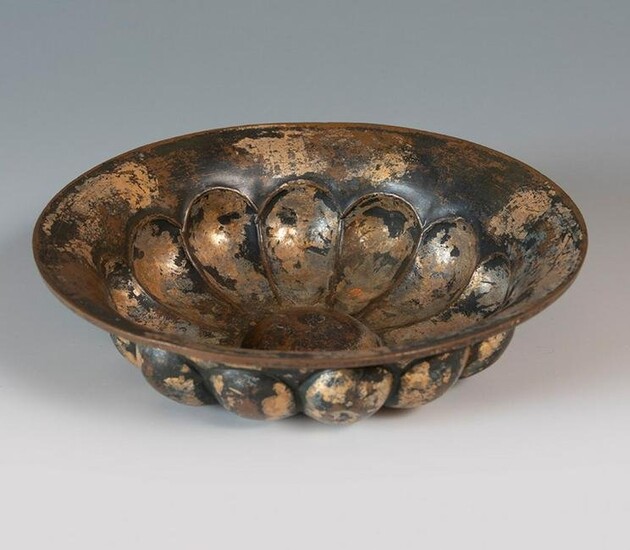Phiale mesonphalos; Achaemenid culture, Iran, 5th
Phiale mesonphalos; Achaemenid culture, Iran, 5th century BC.
Gilded bronze.
In perfect condition, retaining much of the original gilding.
Private collection, London, 1985.
Measurements: 3.5 cm x 14 cm (diameter).
Phiale or Fiale made of gilded bronze with a circular structure with a rounded base and body in the form of ornamentation. This type of vessel is known as a fiale or patera, a round, wide, shallow dish or bowl with no handles or foot, and was mainly used for ritual purposes. According to the sources, this vessel was used especially for libations, non-cruel sacrifices consisting of pouring liquids such as perfume, wine or honey in honour of the divinity. This form would have originated in the Assyrian Empire, as it is depicted on the wall reliefs of the royal palaces of Nimrud, but its history has spanned empires and millennia to become a favourite ritual vessel in Greece and Rome. This specimen evokes the silhouette of the lotus flower, with the central omphalos or umbo highlighted in a semi-globular shape. It is a bowl with a wide open rim, the body of which is worked in volume, emphasising the large petals pointing towards the centre, between which the ribs are interspersed. The delicacy of the metalwork technique, the careful style and the richness of the materials used suggest that this fiale was a prestige object. A fiale made with similar decoration and technique is in the Museo Arqueológico Nacional, Madrid (1999/99/163).
The Achaemenid dynasty ruled the Persian Empire between the mid-6th century BC and the second half of the 4th century BC. It was founded by Cyrus the Great after defeating the last Median king in 550 BC and extending his rule over central Iran and much of Mesopotamia, and came to an end with the conquest of Alexander the Great in 331 BC, after a progressive weakening as a result of the Median wars against the Greeks. Persian art of the Achaemenid period was eclectic and sumptuous, the result of a period of splendour such as the Mediterranean had not seen before. Materials and artists were brought to the court from all the conquered lands, producing a rich mixture of languages and techniques that in itself reflected the Achaemenid empire and thought.
Estimate
Time, Location
Auction House
Phiale mesonphalos; Achaemenid culture, Iran, 5th century BC.
Gilded bronze.
In perfect condition, retaining much of the original gilding.
Private collection, London, 1985.
Measurements: 3.5 cm x 14 cm (diameter).
Phiale or Fiale made of gilded bronze with a circular structure with a rounded base and body in the form of ornamentation. This type of vessel is known as a fiale or patera, a round, wide, shallow dish or bowl with no handles or foot, and was mainly used for ritual purposes. According to the sources, this vessel was used especially for libations, non-cruel sacrifices consisting of pouring liquids such as perfume, wine or honey in honour of the divinity. This form would have originated in the Assyrian Empire, as it is depicted on the wall reliefs of the royal palaces of Nimrud, but its history has spanned empires and millennia to become a favourite ritual vessel in Greece and Rome. This specimen evokes the silhouette of the lotus flower, with the central omphalos or umbo highlighted in a semi-globular shape. It is a bowl with a wide open rim, the body of which is worked in volume, emphasising the large petals pointing towards the centre, between which the ribs are interspersed. The delicacy of the metalwork technique, the careful style and the richness of the materials used suggest that this fiale was a prestige object. A fiale made with similar decoration and technique is in the Museo Arqueológico Nacional, Madrid (1999/99/163).
The Achaemenid dynasty ruled the Persian Empire between the mid-6th century BC and the second half of the 4th century BC. It was founded by Cyrus the Great after defeating the last Median king in 550 BC and extending his rule over central Iran and much of Mesopotamia, and came to an end with the conquest of Alexander the Great in 331 BC, after a progressive weakening as a result of the Median wars against the Greeks. Persian art of the Achaemenid period was eclectic and sumptuous, the result of a period of splendour such as the Mediterranean had not seen before. Materials and artists were brought to the court from all the conquered lands, producing a rich mixture of languages and techniques that in itself reflected the Achaemenid empire and thought.



